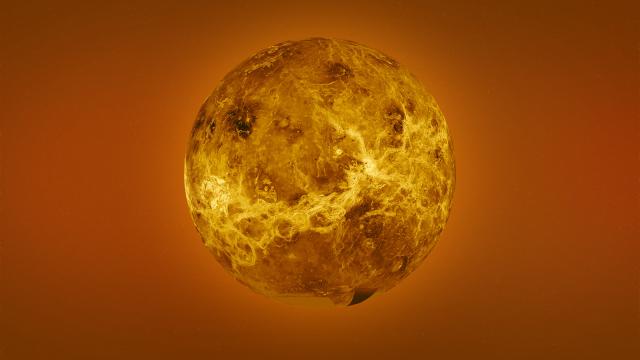Venus might seem rather Earthly, given its similar size and presence of a thick, carbon dioxide-filled atmosphere. But the more scientists observe it, the more surprises the second planet from the Sun throws at us.
Venus. Image: NASA
New results from a simulation continue to paint a strange picture of our noxious neighbour. It seems that an interaction between the planet’s mountains and its atmosphere could create waves strong enough to change the length of a Venusian day by up to two minutes.
Let’s paint a picture of the wacky planet we’re dealing with here. A full rotation takes Venus 243 Earth days, while a single orbit around the Sun takes 225 days. However, the planet rotates in the opposite direction as Earth, so if we consider a “day” as the planet making one full turn, then the Sun actually rises twice during a single day on Venus.
Meanwhile, its cloud tops orbit the planet once every four Earth days, and the atmosphere at its surface is around 90 times denser than Earth’s at sea level.
The Japan Aerospace Exploration Agency has a spacecraft orbiting Venus called Akatsuki. It’s already made some important observations, such as an enormous atmospheric anomaly, a bow-like structure in the planet’s clouds that appears not to move despite the fast winds below.
The team behind the mission hypothesised that this persistent structure is the result of a wave produced when the planet’s speedy winds run up against its mountains, like water flowing over a big rock in a river.
Two researchers from UCLA and another from the University of Paris-Saclay in France popped Akatsuki’s data into a model of Venus’ atmosphere, and the simulation agreed with the previous hypothesis that the strange anomaly was a “gravity wave” resulting from the wind interacting with the mountains. But it also found that, taking these waves into account, the atmosphere could cause a two-Earth-minute fluctuation in how fast Venus rotates on its axis.
This is interesting for several reasons, according to the paper published today in Nature Geoscience. Further studying these waves and how they affect Venus could help scientists better understand its interior, as well as its strange atmosphere. And learning about processes on other planets could help us interpret phenomenon on Earth.
But note that the scientists haven’t actually measured a length-of-day change – they just ran a model that suggested it could be possible. They call out in their new paper that their model has its limits, and direct observation will be needed to truly know what’s happening on Venus.
“Eventually, an accurate measurement of the length-of-day could detect the various impacts of the atmospheric flow against mountains,” they write.
Regardless, it will be a very long time before any humans can experience Venus’ wild weather directly. The planet is the hottest in the Solar System, with an average surface temperature of 467C.
